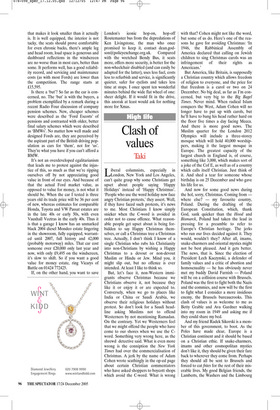Confessions of an anorak
Alan Judd
Am I an anorak? An uncomfortable thought, like discovering that some feature you had never noticed in yourself — your Adam’s apple, perhaps, or your ears — is what people always remember about you. I wore an anorak, long ago during my teenage motor-scooter period. That comprised Lambretta 1, which cost £8, was a slow starter and died of engine seizure, but not before it had caused my motorcycle test to be abandoned by an impatient examiner known locally as Failer Fowler. (That in turn provoked me to remove my L-plates and ride illegally for the rest of my brief two-wheeled career.) Lambretta 2 cost £3 and ran faultlessly until I sold it for £8. The anorak ended up as the thing I used to lie on during the many hours spent beneath my first car.
But now the term is most often used to refer to collectors of anything not thought to be high art. Contentedly absorbed men who stand on station platforms noting train numbers are thus assumed to be sad anoraks. That I should be one, or at least an incipient one, did not occur to me until I was well into Giles Chapman’s new book, Car Badges (Merrell, £12.95). This not only makes sitting in traffic jams even more interesting (sic), but it’s also social and industrial history. It was particularly pleasing to see mention of Eleanor Thornton, who posed nude as the model for RollsRoyce’s famous Spirit of Ecstasy. She was secretary and mistress to Lord Montague, had a secret child by him and perished with her child when the ship on which they were all three sailing to Egypt was torpedoed in 1916. There’s a place for her in the great film yet to be made about the early days of motorism.
And so it was that I was musing on Ford’s ubiquitous Blue Oval badge when a Mondeo Ghia X estate came to stay last week. (For anoraks: the Blue Oval was first used on the 1927 Model A, but the script was on the cars from 1904, provided by a friend of Henry Ford who had designed it for his visiting cards.) The car was the range-topping 3-litre V6 petrol, which has a top speed of 144mph, does 0–60mph in 8.1 seconds and averages mid20s mpg from its 217bhp and 203lb.ft. of torque. I liked it. The engine is smooth and willing, slightly — though not unpleasantly — harsh at high revs and with a sixspeed gearbox as slick and precise as any Honda or Toyota. (I prefer five-speed, but that’s just me.) It’s good-looking, with clean lines and an unassuming presence that makes it look smaller than it actually is. It is well equipped, the interior is not tacky, the seats should prove comfortable for even chronic backs, there’s ample leg and head room, load space is generous and dashboard reflections in the windscreen are no worse than in most cars, better than some. It performs well, has a good reliability record, and servicing and maintenance costs (as with most Fords) are lower than the competition. The range starts at £15,595.
Is there a ‘but’? So far as the car is concerned, no. The ‘but’ is with the buyers, a problem exemplified by a remark during a recent Radio Four discussion of company pension schemes. New, cheaper schemes were described as the ‘Ford Escorts’ of pensions and contrasted with older, better final salary schemes which were described as ‘BMWs’. No matter how well made and designed Fords are, they are perceived by the aspirant part of the British driving population as cars for ‘them’, not for ‘us’. They’re what you have if you can’t afford a BMW.
It’s not an overdeveloped egalitarianism that leads me to protest against the injustice of this, so much as that we’re ripping ourselves off by not appreciating good value in front of our eyes. And because of that the actual Ford market value, as opposed to value for money, is not what it should be. When the car I tested is three years old its trade price will be 36 per cent of new, whereas estimates for comparable Honda, Toyota and VW Passat estates are in the late 40s or early 50s, with even Vauxhall Vectras in the early 40s. Thus it is that a garage I know has an unmarked black 2004 diesel Mondeo estate lingering in the showroom, fully equipped, warranted until 2007, full history and 42,000 (probably motorway) miles. That car cost someone over £20,000 only last year and now, with only £9,495 on the windscreen, it’s slow to shift. So if you want a good value for money estate, ring Vicarys of Battle on 01424 772425.
If, on the other hand, you want to save London’s iconic hop-on, hop-off Routemaster bus from the depredations of Ken Livingstone, the man who once promised to keep it, contact dean.godson@policyexchange.org.uk. Compared with the wretched Bendy Bus, it seats more, offers more security, is better for the non-wheelchair disabled (and can easily be adapted for the latter), uses less fuel, costs less to refurbish and service, is significantly quieter, safer for cyclists and takes less time at stops. I once spent ten wonderful minutes behind the wide flat wheel of one: sheer delight. If it would fit in the drive, this anorak at least would ask for nothing more for Xmas.



















































































 Previous page
Previous page